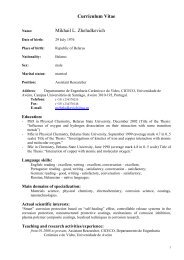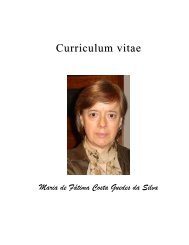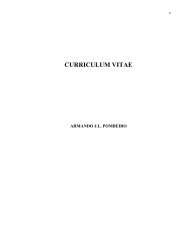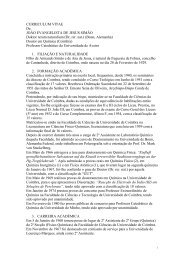XII Iberian Meeting of Electrochemistry XVI Meeting of the ...
XII Iberian Meeting of Electrochemistry XVI Meeting of the ...
XII Iberian Meeting of Electrochemistry XVI Meeting of the ...
Create successful ePaper yourself
Turn your PDF publications into a flip-book with our unique Google optimized e-Paper software.
<strong>XII</strong> <strong>Iberian</strong> <strong>Meeting</strong> <strong>of</strong> <strong>Electrochemistry</strong> & <strong>XVI</strong> <strong>Meeting</strong> <strong>of</strong> <strong>the</strong> Portuguese Electrochemical Society PE 04<br />
Complexes for N L O : Cyclic Voltammetry Study<br />
Ana M. Santos 1,2 , Paulo J. Mendes 2 , Tiago J. L. Silva 1 , M. H. Garcia 1 , M. P.<br />
Robalo 3<br />
1 FCUL, Campo Grande, 1049-001 Lisboa, Portugal<br />
2 Centro de Química de Évora, R. Romão Ramalho 59, 7000-671 Évora, Portugal<br />
3<br />
ADEQ/ISEL, R. Conselheiro Emídio Navarro, 1, 1959-007 Lisboa<br />
margaridaggs@gmail.com<br />
Organometallic compounds continue to attract considerable interest owing to <strong>the</strong>ir<br />
application in <strong>the</strong> field <strong>of</strong> nonlinear optics (NLO) [1]. For second-order nonlinear optics,<br />
strongly asymmetric systems are needed, which led to <strong>the</strong> development <strong>of</strong> typical push<br />
pull systems in which <strong>the</strong> metal centre, bound to a highly polarizable conjugated<br />
backbone, acts as an electron donor (D) or acceptor (A) group. This is <strong>the</strong> case <strong>of</strong> <strong>the</strong><br />
5 -monocyclopentadienylmetal complexes presenting benzene- or<br />
thiophene-based conjugated ligands coordinated to <strong>the</strong> metal centre through nitrile or<br />
acetylide linkages which revealed to be much more efficient donor groups for secondorder<br />
NLO purposes than <strong>the</strong> traditional organic donor groups [2,3]. Recently, a new<br />
promising approach has emerged that is <strong>the</strong> concept <strong>of</strong> switchable second-order<br />
nonlinear optical (SONLO) properties [4]. This makes possible to achieve a switch in<br />
<strong>the</strong> SONLO response between two forms since <strong>the</strong>y have great difference in <strong>the</strong><br />
magnitude <strong>of</strong> <strong>the</strong> corresponding first hyperpolarizabilities. The hyperpolarizability can<br />
be altered, for instance, by reducing <strong>the</strong> donor capacity <strong>of</strong> <strong>the</strong> donor moiety (D) by<br />
oxidation. Thus, <strong>the</strong> presence <strong>of</strong> redox-active metal centers toge<strong>the</strong>r with a<br />
hyperpolarizable conjugated framework provides good opportunities for modulation <strong>of</strong><br />
molecular NLO responses, and is hence a primary justification for <strong>the</strong> study <strong>of</strong> <strong>the</strong>se<br />
systems.<br />
The cyclic voltammetry (CV) plays a role in this field. Besides <strong>the</strong> information about <strong>the</strong><br />
electron richness <strong>of</strong> redox-active centres and <strong>the</strong> correlation with spectroscopic<br />
properties, CV can give an insight on <strong>the</strong> reversibility/stability <strong>of</strong> oxidized and reduced<br />
species. In our ongoing work on <strong>the</strong> study <strong>of</strong> organometallic compounds with molecular<br />
5 -monocyclopentadienyliron(II) and<br />
nickel(II) complexes with substituted thiophene-based ligands in view <strong>of</strong> <strong>the</strong> potential<br />
use <strong>of</strong> <strong>the</strong>se systems as switchable SONLO molecules.<br />
Acknowledgments: We thank to COMPETE/F EDER for financial support (F COMP-01-0124-<br />
F EDER-007433).<br />
References<br />
[1] Goovaerts, E; Wenseleers W.; Garcia, M.H.; Cross G.H. Handbook <strong>of</strong> Advanced Electronic and<br />
Photonic Materials, Ed. H.S. Nalwa, 2001, 9, 127.<br />
[2] Powell, C.M.; Humphrey, M. G. Coord. Chem. Rev. 2004, 248, 725.<br />
[3] Garcia, M.H.; Mendes, P. J.; Robalo, M.P.; Duarte, M.T.; Lopes, N. J. Organomet. Chem. 2009,<br />
694, 2888.<br />
[4] Asselberghs, I.; Clays, K.; Persoons, A; Ward M.; McCleverty, J. J. Mater. Chem. 2004, 14,<br />
2831.<br />
September, 811, 2010. ISEL - Lisbon 95








